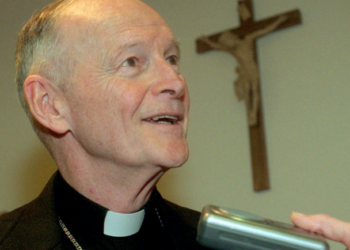Joint U.S.-South Korean (ROK) cooperation in civil nuclear energy—rooted in the two nation’s continued commitment to the Nuclear Non-proliferation Treaty (NPT)—will be key as third-party nations across the world explore new nuclear options.
On April 22, 2025, the 2015 U.S.-ROK Nuclear Agreement will pass the tenth anniversary milestone since its signing. Today, the United States and South Korea are leading the charge in the peaceful expansion of nuclear energy globally, especially in countering China and Russia-led markets. However, today’s advancing diversification and the proliferation of first-of-a-kind nuclear technology presents new and evolving challenges. With nearly thirty nations worldwide actively pursuing the early stages of nuclear energy infrastructure development, maintaining safe, secure, nonproliferation-aligned nuclear industries will be paramount.
The U.S.-South Korean civil nuclear energy partnership can stand as a bulwark against the rise in nuclear proliferation risks. Policy cohesion, however, especially within public-private debates for high-tech industries, requires continuous coordination, understanding, and the reconciliation of competitive positions.
Learning from the Past: A Legacy of Cooperation
Over the last seventy years, the United States and South Korea worked in partnership to expand and develop peaceful nuclear energy in the Indo-Pacific region and beyond. In 1956, shortly after the signing of the ROK-U.S. Mutual Defense Treaty, the United States and South Korea signed their first nuclear cooperation agreement. At that time, South Korea was a war-torn nation focused on rebuilding reliable infrastructure. With financial and technological support from the United States, South Korea constructed and operated its first research and commercial reactors. This initial collaboration laid the groundwork for South Korea’s nuclear energy sector.
In 1974, the ROK-U.S. Nuclear Cooperation Agreement came into effect, playing a critical role in South Korea’s industrial development and was quickly followed by the nation’s first commercial reactor, Kori-1. As South Korea sought to establish a strong heavy industrial base, nuclear energy emerged as a practical avenue to reduce dependency on imported oil and ensure a stable energy supply. Over the decades, South Korea, in close partnership with the United States, has rapidly upscaled its domestic civil nuclear industry. Arguably, U.S.-South Korean cooperation on civil nuclear energy not only advanced South Korea’s energy security but also strengthened the broader alliance by aligning strategic nonproliferation objectives.
South Korea’s Rise: A Capable, Committed Partner
Today, South Korea, ranked fifth in the globe for nuclear energy production, is a responsible nuclear energy power ready to contribute to world-wide civil nuclear governance. Since the 2015 revision of the U.S.-South Korea Agreement Concerning Peaceful Uses of Nuclear Energy (also known as a “123 agreement“), which acknowledged South Korea’s advanced status, the country has continued to strengthen its civil nuclear energy capacities.
Despite facing persistent security challenges, particularly from ongoing and rising North Korean nuclear weapon and missile threats, South Korea continues to affirm its long-term commitments to nonproliferation. A Nuclear Nonproliferation Treaty (NPT) signatory since the 1970s, South Korea remains firmly committed to the U.S.-led international nonproliferation regime, maximizing the peaceful use of nuclear energy while sharing the highest international standards of safety, security, and safeguards.
After decades of investment and effort, with unwavering support from the United States, South Korea has reached a point where it can actively contribute to U.S. objectives in the nuclear sector. South Korean companies, including Korea Hydro & Nuclear Power (KHNP), Doosan Enerbility, and Hyundai Engineering & Construction, equipped with world-class expertise, are eager to collaborate with their U.S. counterparts, and their interests align closely with South Korea’s national priorities. These companies recognize the immense potential for synergy through deeper U.S.-ROK cooperation, which can drive innovation, competitiveness, and market expansion against Russia or China-led cooperation. As more actors and stakeholders from both countries stand to benefit from continued civilian nuclear collaboration, these partnerships will not only deepen trust but also reinforce the long-term stability of the alliance.
The recent Memorandum of Understanding (MOU) on “Principles Concerning Nuclear Exports and Cooperation,” signed by both countries in January, marks an important milestone in enhancing alliance cohesion. This MOU underscores the mutual necessity of integrating South Korea’s growing capabilities while maintaining unity with the United States. It also demonstrates the ability of both countries to accommodate divergent perspectives while preserving a shared strategic purpose—an essential condition for preventing fragmentation.
The MOU is expected to become the foundation for a lasting partnership by providing a framework for the two countries to collaborate on expanding civil nuclear power in third-party countries while strengthening export control measures on civil nuclear technology. Moreover, it paves the way for both countries to stay ahead of emerging technologies and adapt to an evolving nuclear landscape.
Sustaining Momentum: Strengthening the Alliance Through Dual Channels
To strengthen South Korea’s role as a valuable U.S. nuclear alliance partner, there are two diplomatic and geoeconomic approaches which can serve as avenues to strength mutual commitment to nonproliferation and, simultaneously, maximize joint U.S.-ROK cooperation in the global nuclear energy market.
1. Leveraging Bilateral and Multilateral Engagements
A key U.S. Indo-Pacific partner, South Korea plays a complementary and supportive role within the U.S.-led nonproliferation regime. By sustaining and enhancing multilateral nonproliferation efforts, South Korea serves as a core example of peaceful nuclear energy within the region. Of course, U.S.-ROK bilateral security and energy cooperation remains the backbone of the two nations’ nuclear policy coordination. Additionally, South Korea’s participation in multilateral platforms, for example, by leveraging the ROK–UN Joint Conference on Disarmament and Non-Proliferation Issues by expanding access to stakeholders such as emerging nuclear states, private tech firms, and academic institutions, may advance the global nonproliferation norms that the United States has traditionally and continually sought to uphold.
Paradoxically, South Korea’s advocacy for nonproliferation carries even greater weight regionally and globally due to the unique challenges it faces from North Korea’s nuclear threats. Although called into question in recent years, South Korea’s strong national commitment to nonproliferation serves as a powerful example for other nations that may be tempted to deviate from the NPT framework. South Korea’s commitments lend credibility to its civil nuclear industry and positions the nation as an example to other nuclear-curious nations. By leveraging these dual diplomatic channels—bilateral and multilateral—South Korea has strengthened its position as a stabilizing force amid rising regional and cross-regional instability, ensuring that the rules and norms of nonproliferation stands strong in the U.S.-ROK alliance.
2. Serving as a Model for Developing Countries
South Korea is uniquely positioned to serve as a model for developing countries, particularly those that resemble South Korea’s developmental trajectory in the 1950s and 1960s. Having navigated the challenges of building a robust nuclear infrastructure while adhering to non-proliferation norms, South Korea can offer affordable and feasible pathways for developing nations.
International organizations and developing nations have long requested the Korean government share its experience. A good example of this can be found in the KINGS (KEPCO International Nuclear Graduate School), which has been educating students from developing countries or emerging nuclear energy countries about nuclear technology and policy based on South Korea’s exemplary model. Moreover, the Korean Institute of Nuclear Safety and Security (KINAC) hosts international training programs in the fields of nuclear security and nonproliferation, supporting nearly 600 trainees from Eastern Europe, the Middle East, Africa, and Southeast Asia.
The United States, in its efforts to establish nuclear nonproliferation principles in emerging nuclear nations, can point to South Korea as a successful model that balances technological advancement with strict adherence to international safeguards. By partnering with South Korea in this capacity, the United States can enhance its regional credibility and influence in shaping global nonproliferation norms.
Conclusion: A Stronger, More Cohesive Civil Nuclear Alliance
Over the past seventy years, the U.S.-ROK nuclear partnership has evolved from a relationship defined by assistance to one characterized by mutual capability, trust, and shared responsibility. As both nations continue to advance their national technological expertise, a deeper collaboration in the nuclear energy sector offers a powerful mechanism to enhance alliance cohesion and maintain global influence.
By reinforcing mutual commitments and aligning their efforts to promote nonproliferation, the United States and South Korea can ensure that nuclear cooperation remains a cornerstone of their alliance for decades to come.
Kyung-joo Jeon is the Chief of the Korean Peninsula Security Division and a research fellow at the Center for Security and Strategy at the Korea Institute for Defense Analyses (KIDA), Republic of Korea (ROK). At KIDA, she has conducted research on North Korean military and political issues, U.S. extended deterrence, nuclear issues, and ROK defense planning, much of which has been commissioned by the ROK Ministry of National Defense. She is also an adjunct professor at Korea University’s Graduate School of Policy Studies, and a member of the advisory board to the Director of National Security in the Office of the President of the Republic of Korea.
Kayla T. Orta is the Senior Associate at the Hyundai Motor-Korea Foundation Center for Korean History and Public Policy. A former U.S. Department of Defense NSEP Boren Scholar to South Korea, her expertise lies in U.S.-Indo-Pacific and U.S.-Korean foreign relations, especially at the intersection of security and technology policy, including nonproliferation, nuclear diplomacy, and civil nuclear energy markets. Her most recent book, titled “Avoiding Meltdowns & Blackouts: Confidence-building in Inter-Korean Engagement on Nuclear Safety and Energy Development” (Wilson Center, 2023), features insights from U.S. and South Korean nuclear policy experts.
Image: Shutterstock/Niyazz
















